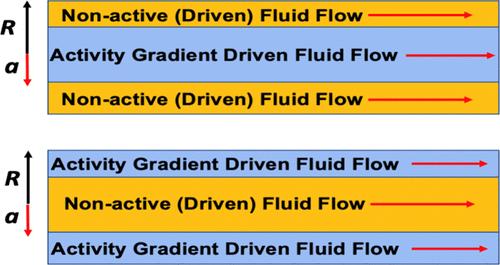不混溶的活性和非活性液体的纳米毛细管核心环流触发无外部驱动的纳米流体液体输送
IF 3.9
2区 化学
Q2 CHEMISTRY, MULTIDISCIPLINARY
引用次数: 0
摘要
在本文中,我们开发了用于研究活性液体和不混溶非活性液体的纳米毛细血管核心-环输运的解析解。活性液体中含有表现出涡旋缺陷的活性颗粒,它会触发圆形极化场,最终在活性(或活性颗粒浓度)存在轴向梯度的情况下,在活性流体内部产生诱导的压力驱动流。这里我们考虑两个不同的场景。对于第一(第二)种情况,活性液体占据核心(环形)区域,而非活性液体占据环形(核心)区域。我们的主要发现是,在这两种情况下,活跃流驱动非活跃流,并且在适当的活性强度(或活性颗粒浓度)存在的情况下,可以实现显著的体积流量(非活跃流);因此,在没有外部驱动(如外部压力梯度或施加轴向电场)的情况下,驱动流体的这种显著的纳米流体输运发生。此外,对于这两种情况,活性液体层的更大厚度增加了整个纳米毛细血管的流动强度,但导致非活性液体的体积流速的非单调变化。此外,对于活性液体占据岩心的情况,较大的活性与非活性液体粘度比显著增强了整体输运;然而,对于另一种情况,粘度比没有影响。最后,我们提供了在纳米毛细管壁上有有限滑移的情况下的分析结果。我们发现,根据不同的情况(活动液体占据岩心或环空区域),滑移长度的不同符号对系统中速度场的总体大小和方向以及被驱动液体的流量有不同的影响。本文章由计算机程序翻译,如有差异,请以英文原文为准。

Nanocapillary Core-Annular Flows of Immiscible Active and Non-Active Liquids Trigger External-Drive-Free Nanofluidic Liquid Transport
In this paper, we develop analytical solutions for investigating the nanocapillary core-annular transport of an active liquid and an immiscible non-active liquid. The active liquid contains active particles that show vortex defects, which trigger a circular polarization field, eventually enabling the generation of an induced pressure-driven flow inside the active fluids in the presence of an axial gradient in the activity (or the concentration of the active particles). Here we consider two separate scenarios. For the first (second) case, the active liquid occupies the core (annular) region while the non-active liquid occupies the annular (core) region. Our main finding is that for both of these cases, the active flow drives the non-active flow and can achieve a significant volume flow rate (of the non-active flow) in the presence of an appropriate strength of activity (or concentration of the active particles); therefore, such significant nanofluidic transport of the driven fluid occurs with no external driving (such as an external pressure gradient or an applied axial electric field). Also, for both of these cases, a greater thickness of the active liquid layer increases the flow strength across the entire nanocapillary but causes a nonmonotonic variation of the volume flow rate of the non-active liquid. Furthermore, for the case where the active liquid occupies the core, a larger active:non-active liquid viscosity ratio significantly enhances the overall transport; however, for the other case, the viscosity ratio has no effect. Finally, we provide our analytical results for the case where there is a finite slip at the nanocapillary walls. We find that depending on the scenario (active liquid occupying the core or the annular region), different signs of the slip lengths have different influences on the overall magnitude and direction of the velocity field in the system and the flow rate in the driven liquid.
求助全文
通过发布文献求助,成功后即可免费获取论文全文。
去求助
来源期刊

Langmuir
化学-材料科学:综合
CiteScore
6.50
自引率
10.30%
发文量
1464
审稿时长
2.1 months
期刊介绍:
Langmuir is an interdisciplinary journal publishing articles in the following subject categories:
Colloids: surfactants and self-assembly, dispersions, emulsions, foams
Interfaces: adsorption, reactions, films, forces
Biological Interfaces: biocolloids, biomolecular and biomimetic materials
Materials: nano- and mesostructured materials, polymers, gels, liquid crystals
Electrochemistry: interfacial charge transfer, charge transport, electrocatalysis, electrokinetic phenomena, bioelectrochemistry
Devices and Applications: sensors, fluidics, patterning, catalysis, photonic crystals
However, when high-impact, original work is submitted that does not fit within the above categories, decisions to accept or decline such papers will be based on one criteria: What Would Irving Do?
Langmuir ranks #2 in citations out of 136 journals in the category of Physical Chemistry with 113,157 total citations. The journal received an Impact Factor of 4.384*.
This journal is also indexed in the categories of Materials Science (ranked #1) and Multidisciplinary Chemistry (ranked #5).
 求助内容:
求助内容: 应助结果提醒方式:
应助结果提醒方式:


